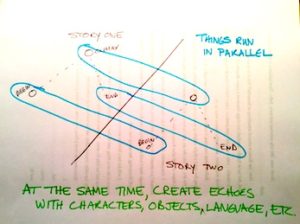News and More Stuff from Chez Rambo
Happy end of the year to all of you!
UPDATE: This went so well and everyone was so grateful that I went ahead and extended the sale through the end of the year. There are new links below to coupons that should let you access the classes at the $5 price. Let me know if there are any issues!
We are wrapping up the end of the year with a special promotion for THREE DAYS ONLY, December 24-26, by offering all Rambo Academy for Wayward Writers on-demand classes, including the ones from Ann Leckie, Rachel Swirsky, and Juliette Wade, for $5 or less.
Yep, that’s right. For less than $50Â you can, in fact, buy access to every class we currently offer. Did I mention it’s only through midnight of the 26th, aka three days (well, a little more since this is going out Sunday evening) only?
This is a let’s-close-out-2018-with-a-bang promotion and won’t be repeated again until next December (if we do). Here insert me talking in a Thunderdome announcer’s voice and repeating that vital phrase, THREE DAYS ONLY.
Seriously, though. If you want to pick up one (or many) of the classes, now’s the time, and you have lifetime (well, Teachable’s lifetime, which may or may not match mine or yours) access. And pass this offer along to as many people as you like, particularly your writing groups and friends. The more the merrier.
Want a live class? There’s still a few slots open in Stories That Change Our World as well as all the other live January classes, including opportunities with Seanan McGuire, Rachel Swirsky, and Fran Wilde.
And look for plenty of new Rambo Academy material there in the coming year, including on-demand versions of the Flash Fiction workshop, Punk U: How to Write -punk Fiction, Rachel Swirsky’s Speculative Poetry class, James Sutter’s High-Speed Worldbuilding, a class from Diane Morrison on time management and writing in odd moments “” and more.
Click on the links to access the sale coupons:
Character Building Workshop for $5
Description and Delivering Information for Genre Writers for $5
Hex Engines & Spell-Slingers: Write Steampunk/Weird Western for $5
Literary Techniques for Genre Writers for $5
Moving from Idea to Finished Draft for $5
Old Stories Into New with Rachel Swirsky for $5
The Power of Words with Juliette Wade for $5
Reading to an Audience Workshop for $3
Rewriting, Revising, and Fine-Tuning Your Fiction for $5
To Space Opera and Beyond with Ann Leckie for $5
Recent Stuff from the Blog and Patreon
I’m continuing to update the listing of awards posts from F&SF publishing people every few days. Let me know if yours should be on there.I talked about the process behind the development of one of my favorite stories, “Rappacini’s Crow.”
I tried to consolidate a lot of useful resources for F&SF writers into this page, and am working on one for online writing workshops next. Suggestions for items to include on either page are welcome.
J.D. Moyer on Writer’s Workshops with Kim Stanley Robinson
Bitterballen ““Â Carleton Chinner Presents The Tastiest Snack You’ve Never Heard Of
Jennifer Lee Rossman talks about her new novel, Jack Jetstark’s Intergalactic Freakshow
Edward M. Erdelac talks about his novel The Knight With Two Swords and The Women of Arthurian LoreÂ
Interested in doing a guest blog post? The guidelines are newly updated to include more possibilities.
This month I featured a charity for holiday giving each day on my Patreon page. You can find them all here, regardless of whether or not you’re a Patreon supporter. Other things supporters got included a Q&A with Taco, photos of the current craft project, recipes, writing tips and resources, market news, snippets, and access to the Chez Rambo Discord server. Check out the Patreon page to find out how you can join our community!
The December giveaway is a novel critique by Cat. Mail me at cat AT kittywumpus.net by midnight December 31 with the subject line “December 2018 Giveaway.”






 Cussin’ in Secondary Worlds
Cussin’ in Secondary Worlds
One Response